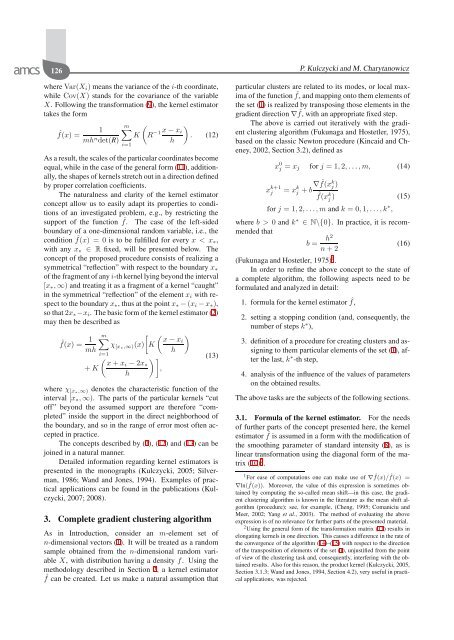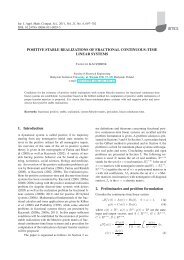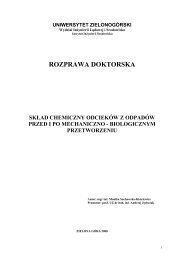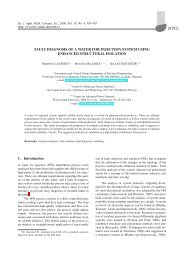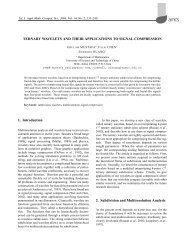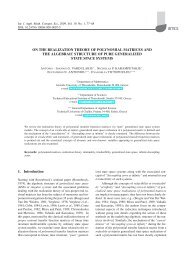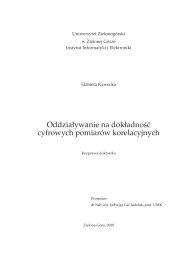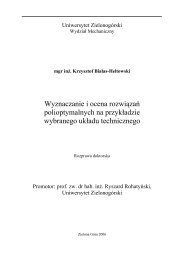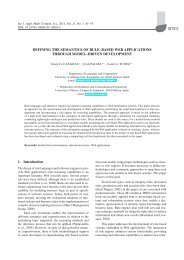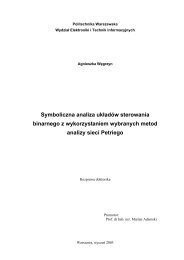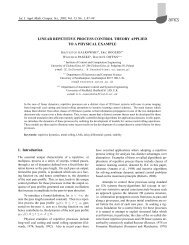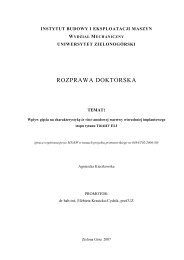A complete gradient clustering algorithm formed with kernel estimators
A complete gradient clustering algorithm formed with kernel estimators
A complete gradient clustering algorithm formed with kernel estimators
You also want an ePaper? Increase the reach of your titles
YUMPU automatically turns print PDFs into web optimized ePapers that Google loves.
126 P. Kulczycki and M. Charytanowicz<br />
where Var(X i ) means the variance of the i-th coordinate,<br />
while Cov(X) stands for the covariance of the variable<br />
X. Following the transformation (9), the <strong>kernel</strong> estimator<br />
takes the form<br />
ˆf(x) =<br />
1<br />
mh n det(R)<br />
m∑<br />
i=1<br />
(<br />
K R −1 x − x )<br />
i<br />
. (12)<br />
h<br />
As a result, the scales of the particular coordinates become<br />
equal, while in the case of the general form (11), additionally,<br />
the shapes of <strong>kernel</strong>s stretch out in a direction defined<br />
by proper correlation coefficients.<br />
The naturalness and clarity of the <strong>kernel</strong> estimator<br />
concept allow us to easily adapt its properties to conditions<br />
of an investigated problem, e.g., by restricting the<br />
support of the function ˆf. The case of the left-sided<br />
boundary of a one-dimensional random variable, i.e., the<br />
condition ˆf(x) =0is to be fulfilled for every x0 and k ∗ ∈ N\{0}. In practice, it is recommended<br />
that<br />
b =<br />
h2<br />
(16)<br />
n +2<br />
(Fukunaga and Hostetler, 1975) 1 .<br />
In order to refine the above concept to the state of<br />
a <strong>complete</strong> <strong>algorithm</strong>, the following aspects need to be<br />
formulated and analyzed in detail:<br />
1. formula for the <strong>kernel</strong> estimator ˆf,<br />
2. setting a stopping condition (and, consequently, the<br />
number of steps k ∗ ),<br />
3. definition of a procedure for creating clusters and assigning<br />
to them particular elements of the set (1), after<br />
the last, k ∗ -th step,<br />
4. analysis of the influence of the values of parameters<br />
on the obtained results.<br />
The above tasks are the subjects of the following sections.<br />
3.1. Formula of the <strong>kernel</strong> estimator. For the needs<br />
of further parts of the concept presented here, the <strong>kernel</strong><br />
estimator ˆf is assumed in a form <strong>with</strong> the modification of<br />
the smoothing parameter of standard intensity (8), as is<br />
linear transformation using the diagonal form of the matrix<br />
(10) 2 .<br />
1 For ease of computations one can make use of ∇ ˆf(x)/ ˆf(x) =<br />
∇ln( ˆf(x)). Moreover, the value of this expression is sometimes obtained<br />
by computing the so-called mean shift—in this case, the <strong>gradient</strong><br />
<strong>clustering</strong> <strong>algorithm</strong> is known in the literature as the mean shift <strong>algorithm</strong><br />
(procedure); see, for example, (Cheng, 1995; Comaniciu and<br />
Meer, 2002; Yang et al., 2003). The method of evaluating the above<br />
expression is of no relevance for further parts of the presented material.<br />
2 Using the general form of the transformation matrix (11) results in<br />
elongating <strong>kernel</strong>s in one direction. This causes a difference in the rate of<br />
the convergence of the <strong>algorithm</strong> (14)–(15) <strong>with</strong> respect to the direction<br />
of the transposition of elements of the set (1), unjustified from the point<br />
of view of the <strong>clustering</strong> task and, consequently, interfering <strong>with</strong> the obtained<br />
results. Also for this reason, the product <strong>kernel</strong> (Kulczycki, 2005,<br />
Section 3.1.3; Wand and Jones, 1994, Section 4.2), very useful in practical<br />
applications, was rejected.


